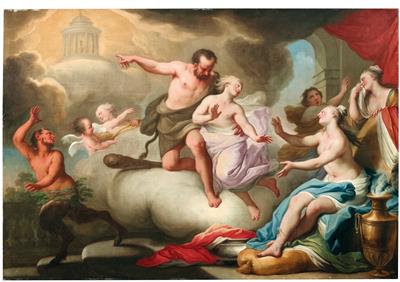Andrea Casali

(Rome 1705–1784)
Hercules shows the way to the temple of virtue,
signed and dated lower right (on the urn),
oil on canvas, 176.5 x 258.5 cm, framed
Provenance:
Private collection, Milan;
where acquired by the present owner
The present painting represents several episodes within a single composition from the myth of Hercules and Omphale, Queen of Lydia. Hercules killed Iphitus, the son of Eurytus, and because of this he became ill. The oracle at Delphi, represented in the upper left of composition, prophesised that he would only be healed after having expiated his sin by becoming a slave, to alleviate his crime. Queen Omphale hearing of the hero’s deeds, chose to buy him and make him her slave. Hercules remained in her palace for three years during which time he was forced to dress as a woman and to spin wool. Although Hercules became Omphale’s lover during his servitude, he also fell in love with Malide, one of the queen’s servants, who in the painting may be identified as the maiden embraced by the hero.
The myth of Hercules and Omphale is also tied to the myth of Pan, seen here on the left of the canvas; he in turn had fallen in love with the queen. The sources tell how the two lovers, Hercules and Omphale, finding themselves among the vineyards of Tmolo stopped at a grotto near the forest of Baccus to spend the night, and in playful spirit swapped clothes. Pan entered the grotto, and believing he was stealing into bed with Omphale he found himself instead with Hercules.
The present large scale mythological painting belongs to Andrea Casali’s English period during which he prevalently made portraits, but also religious and decorative subjects. He trained in the studio of Sebastiano Conca before being apprenticed to Francesco Trevisani. In 1725 he entered the Concorso Clementino and in 1729 he was knighted by Benedict XIII for his frescoes in the cloister of San Sisto Vecchio, Rome. In 1740 at the invitation of various British noblemen among them Sir Charles Frederick and the Earl of Carlisle, Casali decided to go to England travelling through Paris. He remained there for twenty-five years. In 1753, the year he made the present painting, Casali executed a decorative cycle representing Poetry, Painting and Sculpture for the entrance hall of Ranston House in Dorset, while he supplied the ceiling of the saloon with two ovals representing Bacchus and Ariadne and Music or Saint Cecilia. Casali won four prizes at the Society of Artists and the Free Society where he exhibited regularly. In 1762 and in 1766 he organised sales of his works and of various paintings he owned by Italian and Dutch masters; immediately after the latter sale he returned to Italy and he died at Rome in 1784.
30.04.2019 - 17:00
- Estimate:
-
EUR 80,000.- to EUR 100,000.-
Andrea Casali
(Rome 1705–1784)
Hercules shows the way to the temple of virtue,
signed and dated lower right (on the urn),
oil on canvas, 176.5 x 258.5 cm, framed
Provenance:
Private collection, Milan;
where acquired by the present owner
The present painting represents several episodes within a single composition from the myth of Hercules and Omphale, Queen of Lydia. Hercules killed Iphitus, the son of Eurytus, and because of this he became ill. The oracle at Delphi, represented in the upper left of composition, prophesised that he would only be healed after having expiated his sin by becoming a slave, to alleviate his crime. Queen Omphale hearing of the hero’s deeds, chose to buy him and make him her slave. Hercules remained in her palace for three years during which time he was forced to dress as a woman and to spin wool. Although Hercules became Omphale’s lover during his servitude, he also fell in love with Malide, one of the queen’s servants, who in the painting may be identified as the maiden embraced by the hero.
The myth of Hercules and Omphale is also tied to the myth of Pan, seen here on the left of the canvas; he in turn had fallen in love with the queen. The sources tell how the two lovers, Hercules and Omphale, finding themselves among the vineyards of Tmolo stopped at a grotto near the forest of Baccus to spend the night, and in playful spirit swapped clothes. Pan entered the grotto, and believing he was stealing into bed with Omphale he found himself instead with Hercules.
The present large scale mythological painting belongs to Andrea Casali’s English period during which he prevalently made portraits, but also religious and decorative subjects. He trained in the studio of Sebastiano Conca before being apprenticed to Francesco Trevisani. In 1725 he entered the Concorso Clementino and in 1729 he was knighted by Benedict XIII for his frescoes in the cloister of San Sisto Vecchio, Rome. In 1740 at the invitation of various British noblemen among them Sir Charles Frederick and the Earl of Carlisle, Casali decided to go to England travelling through Paris. He remained there for twenty-five years. In 1753, the year he made the present painting, Casali executed a decorative cycle representing Poetry, Painting and Sculpture for the entrance hall of Ranston House in Dorset, while he supplied the ceiling of the saloon with two ovals representing Bacchus and Ariadne and Music or Saint Cecilia. Casali won four prizes at the Society of Artists and the Free Society where he exhibited regularly. In 1762 and in 1766 he organised sales of his works and of various paintings he owned by Italian and Dutch masters; immediately after the latter sale he returned to Italy and he died at Rome in 1784.
|
Buyers hotline
Mon.-Fri.: 10.00am - 5.00pm
old.masters@dorotheum.at +43 1 515 60 403 |
| Auction: | Old Master Paintings |
| Auction type: | Saleroom auction |
| Date: | 30.04.2019 - 17:00 |
| Location: | Vienna | Palais Dorotheum |
| Exhibition: | 20.04. - 30.04.2019 |
